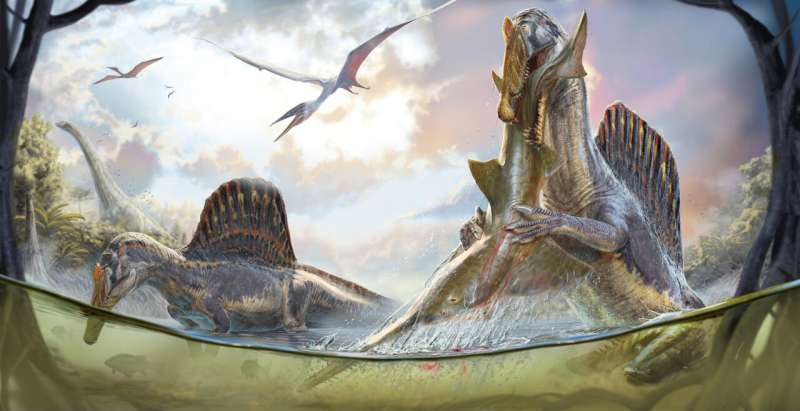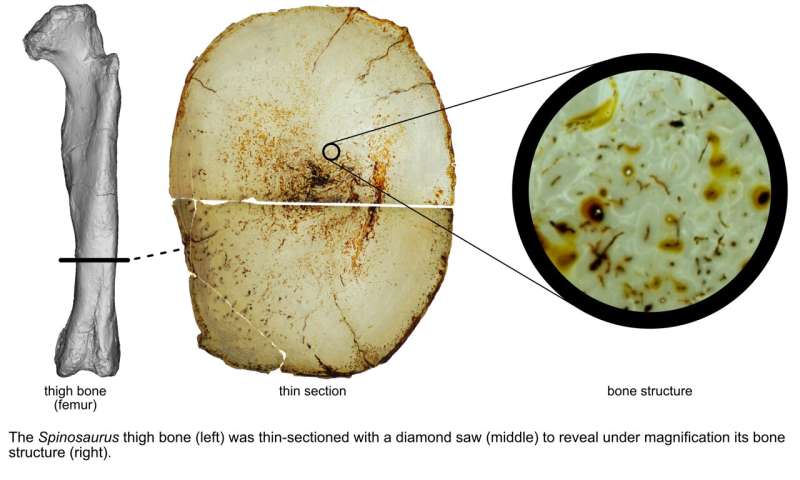This article has been reviewed according to Science X's editorial process and policies. Editors have highlighted the following attributes while ensuring the content's credibility:
fact-checked
peer-reviewed publication
trusted source
proofread
New analysis uncovers major issues with earlier suggestions that Spinosaurus pursued prey underwater

For years, controversy has swirled around how a Cretaceous-era, sail-backed dinosaur—the giant Spinosaurus aegyptiacus—hunted its prey. Spinosaurus was among the largest predators ever to prowl the Earth and one of the most adapted to water, but was it an aquatic denizen of the seas, diving deep to chase down its meals, or a semiaquatic wader that snatched prey from the shallows close to shore?
A new analysis led by paleontologists from the University of Chicago reexamines the density of its bones as a way of determining its life habits in water.
Deep water swimmer or shoreline predator?
When detailed descriptions of a nearly complete specimen of Spinosaurus were first published in Science in 2014, a UChicago-led research team pitched it as a shoreline stalking or surface swimming demon, not a fully aquatic underwater predator.
Later in 2020, an international group of researchers countered that description with a study in Nature, using its newly discovered, tall-spined tail bones to suggest that it propelled itself like an eel to hunt underwater.
A 2022 study by many of those same authors confirmed their 2020 assessment showing that Spinosaurus had dense bones to use as ballast in diving like a penguin. They also argued that some other spinosaurids, such as its older African cousin Suchomimus, had less dense bones and were likely waders.
About the same time in 2022, a group of paleontologists at UChicago teamed up with colleagues elsewhere to test these ideas by creating digital skeletons and flesh models of the Spinosaurus and Suchomimus. Their results, published in eLife, found that both species would have been unstable when swimming at the surface and far too buoyant to dive and fully submerge.
Now that same team has taken on the question of bone density, led by senior author Paul Sereno, Ph.D., from UChicago and first author Nathan Myhrvold, Ph.D., Founder and CEO of Intellectual Ventures. Their study, "Diving dinosaurs? Caveats on the use of bone compactness and pFDA for inferring lifestyle," appears in the journal PLOS ONE.
"We had made the thin sections of these species that were used for bone density calculations, and so we thought we would start by trying to replicate their measurements," said Sereno, who is a Professor of Organismal Biology and Anatomy at UChicago and co-led the initial discovery of the new Spinosaurus specimen in 2014. "But we encountered many factors that generated a range of values—enough to undermine the conclusions."

New calculations for ancient fossils
The team began by asking new questions about bone density, such as how to digitize thin sections, where to slice through the thigh and rib bones, and whether to include bones from more than one individual.
Some modern aquatic mammals like manatees have swollen, dense bones to help them stay underwater, like a scuba diver's weight belt. Large land animals, like elephants and dinosaurs, also have dense bones to support their increased body mass. Most modern birds and many dinosaurs including Spinosaurus have the opposite condition, with air sacs attached to lungs or inside bones that act like a life vest preventing submergence. Assessing the aquatic abilities of an extinct species like Spinosaurus needs to take account of all these factors.
Given the complexity of understanding the meaning of bone density, Sereno and team worked with Myhrvold to reevaluate how the statistical technique used in the 2022 Nature study was applied to support the claim that Spinosaurus was a deep diver. The approach, known as phylogenetic flexible discriminant analysis (pFDA), is like machine learning: the pFDA technique trains a classification algorithm on a group of species whose lifestyle is well understood.
In principle, researchers could then use the algorithm to estimate the likelihood that a poorly understood species such as Spinosaurus falls into one behavioral group or another. In practice, however, Myhrvold said there are problems that must be overcome.
"Unfortunately, that technique does not work properly unless you have lots of data, you make apples-to-apples comparisons, and you check that the data meet certain statistical prerequisites," he said. "None of those requirements were met in that earlier study, so the results just didn't hold up under reexamination."
The new paper should help paleontologists understand the pitfalls of pFDA and other kinds of broad statistical analyses and how to avoid them. The researchers show that it is important to use consistent and objective criteria to decide which species to include and exclude, as well as how to classify their behavior. The findings also demonstrate the importance of taking measurement errors and individual variations into account when assessing bone density.
"We think Spinosaurus, one of the largest predatory animals ever to have evolved, needed extra bone strength to support its weight on its relatively short hind limbs," Sereno said.
"Spinosaurus was able to wade into waterways more than six feet deep without floating, where it could ambush fish of any size with its claws and jaws—but all while keeping its toes firmly anchored in the mud."
More information: Diving dinosaurs? Caveats on the use of bone compactness and pFDA for inferring lifestyle, PLoS ONE (2024). DOI: 10.1371/journal.pone.0298957
Provided by University of Chicago





















